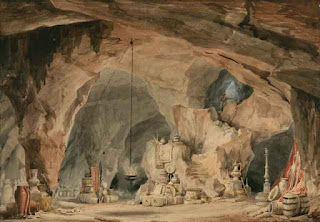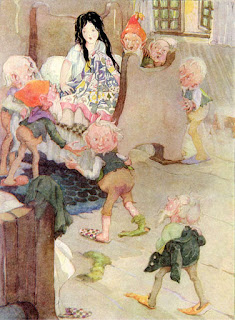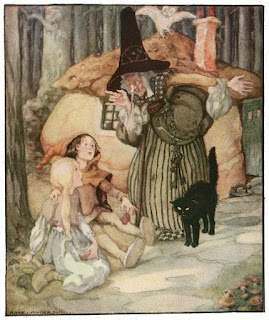Ali Baba Pictures
Free Images of Ali Baba and 40 Thieves
Ali Baba and the 40 Thieves is one of the three most popular fairy tales from Arabian Nights (1001 Nights), which are also the most controversial due to their vague origin. A lot of scholars believe they were actually written by Gallimard, who was supposed to collect and translate traditional tales. It's not our intention to discover the truth about the Ali Baba's authorship. We will only enjoy, as far as we know, the largest collection of Public Doman color images from Ali Baba and Forty Thieves. If you are familiar with the story, you already expect a lot of depictions of the thieves' den and Morgiana's fatal dance.
Let's start!
Frank Adams (1871-1944)
Ali Baba and 40 Thieves features one of the most powerful female characters in the fairy world. While she is not even mentioned in the title, she actively helps her master and even saves him and his family's lives.
Morgiana is pulling boiled oil over the hidden robbers. The scene is from My Nursery Story Book, published around 1930.
Robert Arthur (1850-1914)
This popular fairy tale was adapted for the theater stage many times. Here is an example of a promotional poster.
We don't know when this production took place, but according to the poster it was executed as 'Christmas pantomime'.
Roger Broders (1883-1953)
Roger Broders was a successful travel poster artist, but he occasionally illustrated a book or two.
All images above come from the 1946 edition by Tours, Maison Mame, Paris. The book features two fairy tales from 1001 Nights (Prince Ahmed being the second).
Frances Brundage (1854-1937)
Frances Brundage was quite a hyperactive illustrator, so we should not be surprised to find out she illustrated the story about Ali Baba on different occasions for different publishers.
This cover was created for Charles E. Graham & Co., New York.
The Arabian Nights, published by Raphael Tuck & Sons in 1893, was illustrated by Frances and her husband Will.
Another depiction of the fatal Morgiana's dance was illustrated by Brundage in 1924 and published by Saalfield Publishing Company, Akron, Ohio.
Rene Bull (1872-1942)
'Open sesame!' is one of the best-known magical words. Millions of kids probably heard of sesame through this fairy tale.
Morgiana is a faithful servant and a cold-blooded killer.
Rene Bull illustrated Arabian Nights in 1912 for Constable & Co., London. The first edition of this book (in good condition) is worth several hundred dollars.
Pierre-Luc-Charles Ciceri (1782-1868)
As we already know, Ali Baba inspired stage productions, too. Pierre-Luc-Charles Ciceri imagined the bandit's den, as we can see below:
The play in four acts was performed in 1832.
Walter Crane (1845-1915)
Walter Crane illustrated a picture book about Ali Baba in 1873. In the next decades, the book was reprinted in various versions.
Crane not only illustrated his picture books but also adapted text, chose typography, and designed the layout.
Edmund Dulac (1882-1953)
Edmund Dulac illustrated Ali Baba for the Stories from the Arabian Nights, published in 1907 by Hodder & Stoughton, London.
"Ali Baba departed for the town a well satisfied man"
"Greater still was the exultation of a greedy nature like that of Cassim’s""He assumed a disguise suitable to his purpose"
"Then for the last figure of all she drew out the dagger"The four scenes above represent the four major characters from the story.
John Hassall (1868-1948)
The next scene is from Dodge's Red Picture Book (Fairy tales for little folk) from around 1910.
This book, published by Dodge Publishing Co., New York, is a collection of popular classic fairy tales, including Sleeping Beauty, Little Red Riding Hood, and Puss in Boots, not limited only to Arabian Nights.
The image above is a gouache painting from a private collection. It's titled Knife Dancer and is obviously inspired by the Morgiana's dance in the story of Ali Baba.Albert Edward Jackson (1873-1952)
The cover from Arabian Nights, 1937 reprint.
"Is it time?" "Not yet, but presently."
"Morgiana danced with great dance and agility"
The cover and the illustrations with the captions were created for Ward, Lock& Co. Limited, London, around 1920.
Carl Offterdinger (1829-1889)
Offterdinger is best known for his illustrations of the Grimms' fairy tales, yet he could not resist 1001 Nights either.
The scene with Morgiana and a dagger was created in his later years, very likely in the 1880s.
Albert Robida (1848-1926)
It's very hard to find reliable data about the originals, so we have to be satisfied with reproductions from 1945.
There's a whole series of color and black-and-white drawings of Ali Baba and 40 Thieves by Robida.
William Heath Robinson (1872-1944)
W. H. Robinson illustrated Arabian Nights for George Newnes Ltd., London, in 1899. Ali Baba is only one of many illustrated stories, including Aladdin, Ebony Horse, and Sinbad.
Max Slevogt (1868-1932)
Max Slevogt created a series of Ali Baba-themed watercolors on smooth vellum around 1900. With additional illustrations, they were published in 1903 by Bruno Cassirer in Berlin.
Most of the originals are in museums, but you can find a complete set online as well.
George Soper (1870-1942)
The scene with Morgiana putting the boiling oil into jars with hidden thieves was published around 1902 by George Allen & Unwin Ltd., London.
Virginia Frances Sterrett (1900-1931)
Virginia Frances Sterrett illustrated only three books during her short life. Arabian Nights, published by Penn Publishing Co., Philadelphia in 1928 was one of them.
Apart from the presented color plates, she created black-and-white line drawings, too.
Charles Jay Taylor (1855–1929)
The next image was created as a caricature for Puck Magazine as a commentary on notorious McKinley's tariffs in 1896.William McKinley, a representative of Congress, proposed a raise of the average duty on imports by 50% in 1890 to protect domestic production. This protectionistic act didn't bring promised results, and tariffs were already lowered by the time of creation of the satirical painting above.
Harry George Theaker (1873–1954)
Open sesame!
The dagger always comes at the end. Always.
If you liked these images, don't hesitate to share them with your friends. Visit our other posts with vintage fairy tale pictures, too.







































Komentarji
Objavite komentar